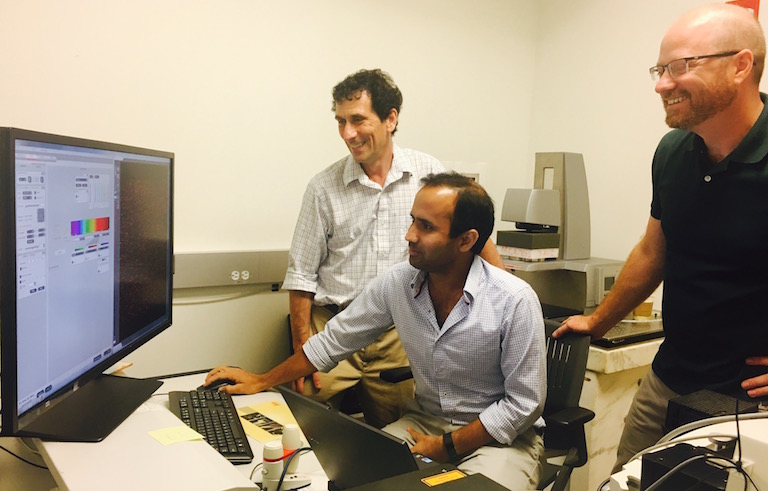Urbach, Blair Publish Paper on Shear Thickening Fluids

Professors Jeff Urbach and Daniel Blair (standing) watch postdoctoral researcher Vikram Rathee work in their lab. The team published a paper on shear thickening fluids this week. (Photo: Patrick Curran/Georgetown College)
August 3, 2017 — Jeff Urbach and Daniel Blair, professors in the Georgetown College Department of Physics and the Institute for Soft Matter Synthesis and Metrology, published a groundbreaking paper on shear thickening fluids, also known as non-Newtonian fluids, in the journal Proceedings of the National Academy of Sciences this week.
The paper, titled “Localized Stress Fluctuations Drive Shear Thickening in Dense Suspensions,” examined the ways that shear thickening fluids react to applied stress.
The material Urbach and Blair work with may be surprisingly familiar to the layman: “Oobleck,” the mixture of corn starch and water frequently present at elementary school science fairs, is an example of a shear thickening fluid, a fluid that becomes more viscous, or “thicker”, as it is exposed to more stress. The Georgetown researchers worked with a material that isn’t simply corn starch and water, but it shares the special properties that make oobleck so fascinating — that is, it changes behavior from a liquid to a solid when exposed to increasing levels of stress.
Of course, you don’t get published in academic journals just for playing with oobleck. Urbach, Blair, and postdoctoral researcher Vikram Rathee observed the way the shear thickening fluid behaves on a microscopic level.
Previous experimental studies of these materials had only measured the average viscosity of the shear thickening fluid. The Georgetown team sought to directly observe the effect of the shear thickening, so they invented an innovative technique:
The shear thickening fluid is sandwiched between two very carefully engineered surfaces. The top surface is a plate, connected to a machine called a rheometer that can apply an extremely precise amount of force to the fluid. The bottom plate is a thin elastic film coated with microscopic beads attached to a piece of glass. When a force is applied to the top plate, it’s transmitted though the shear thickening fluid, producing movements in the beads.
The innovation comes from their ability to track the motions of the beads by using a laser scanning microscope. Using image processing algorithms, the team was able to convert the motion of the beads to extremely precise measurements of the forces from the fluid, providing the first ever look into the way shear thickening fluids actually work.
“Imagine you’re stirring a vat of fluid,” Urbach said. “The fluid is pulling on the sides of the container — there’s force there. With what we’re doing now, we can see those forces. We coat the glass with a thin layer of a relatively soft material, and we know exactly how soft. We measure what the fluid does to that material, and we see if it all moves uniformly, or if some parts move more than others.”
Their findings were quite surprising. Rather than the fluid becoming uniformly thicker at a constant rate as more force was applied, the movements of the thin layer on the boundary revealed small distinct regions representing transient clumps of more viscous fluid, with no apparent pattern to the appearance and disappearance of the clumps. More pressure did not lead to the clumps getting any thicker (more viscous), but to a higher frequency of clumps in a given area of the suspension.
“Even in a regime where the overall properties seem to grow smoothly, we saw very large variations. Some places acted like a very thick fluid, and others acted like a very low-viscosity fluid,” Urbach said.
Advances in shear thickening fluid technology have enormous implications in the modern world. One example of a potential application is body armor that could adapt easily to the movements of its wearer, then become instantly rigid if a bullet or blade attempted to penetrate it. Of course, as Blair points out, the fluid in this application would need to be carefully designed.
“You want to be able to design in something about your material so that it thickens in a certain range,” Blair said. “You don’t want the soldiers to run as fast as they can and all of the sudden their body armor becomes totally stiff. You want to design the system in the proper way, so understanding how the surfaces interact is important.”
That’s where Urbach and Blair’s research comes in. Their most recent paper is part of an ongoing process in which they’ll attempt to manipulate when and how a shear-thickening fluid changes from liquid to solid. Changing its behavior in a wholly predictable fashion is still a ways off, but their most recent findings on the inhomogeneous thickening behavior will help inform further research.
The next step will involve changing the properties of particles within the shear-thickening fluid in hopes of modifying how it behaves when stress is applied.
“For example, these particles are spheres. If you make them into rods instead, you still get the transition [from liquid- to solid-like properties], but you don’t have to put as much stuff in,” Blair said. “You can do it at much lower concentrations of solids, which would cut down on weight, processing, and lots of other things. It lets you expand the range over which the process happens.”
— Patrick Curran